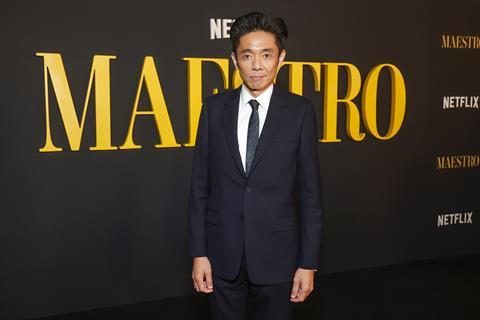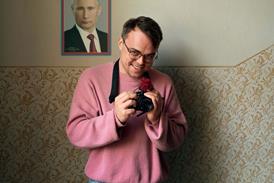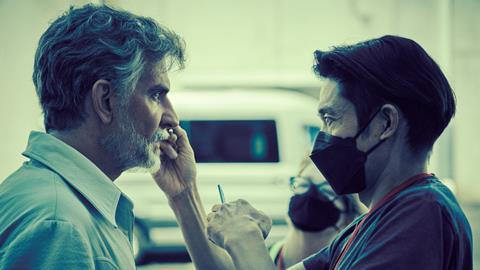A lot of things in Hollywood can seem chaotic, sometimes even random, or serendipitous. But it feels more like fate that Kazu Hiro watched a documentary in the early 1990s about the US composer and conductor Leonard Bernstein, and said to himself, “I want to work on a film about him someday.” Now Hiro finds himself Oscar- and Bafta-nominated (alongside others in the make-up and hair team) for doing just that.
“His energy inspired me,” says Hiro, who was a self-taught budding prosthetic make-up artist in Japan when he learned about “Lenny”, as he came to call him. “He’s so iconic. And I think he has an attractive face, which also reflects what’s inside.”
Maestro is Bradley Cooper’s — and Hiro’s — magnum opus. Cooper co-wrote, produced, directed and starred in the film that chronicles the life and work of Bernstein and his tumultuous relationship with wife Felicia Montealegre, played by Carey Mulligan. Jake Gyllenhaal was in the running to make his own film about the late composer, but Cooper ultimately won the bid for life and music rights to Bernstein’s estate in 2018, and proceeded with Netflix’s backing.
For Hiro, Maestro presented the opportunity to combine his two passions: real-life character likeness and ageing. Monsters, creatures, gore — that does not interest Hiro, who, after becoming disillusioned with the film industry, transitioned away from Hollywood a decade ago and began sculpting large-scale hyperrealist portraits of famed individuals such as Salvador Dali, Frida Kahlo and Abraham Lincoln.
“I feel like [Cooper] re-educated me in how to be a make-up artist,” says Hiro, who returned to filmmaking at the behest of Gary Oldman for his role as Winston Churchill in 2017’s Darkest Hour, and then turned John Lithgow into Fox News CEO Roger Ailes for 2019’s Bombshell — winning the Oscar and Bafta for both films. “[Bradley] gave us freedom to fail, to make something better, and to succeed. His openness, his honesty, that’s hard to get from anyone [in the film industry]. He was willing to fail in front of everybody.”
Creative choices

Cooper and Hiro began their conversations about Maestro in early 2020, but filming did not commence until May 2022. From the beginning, they both felt the most important part of the transformation was going to be nailing the likeness of Bernstein at every stage of his life — the story runs from 1943 (aged 25) to 1989 (aged 71). Hiro broke the script into five stages to represent ageing.
Initially, when Hiro asked Cooper how exact he wanted to go with the likeness of Bernstein, he replied, “As close as I can.” But it was the first time Cooper had donned this much prosthetic make-up for a role, and after several tests, they knew they needed to pull back a little bit. Cooper has sensitive eyes and Bernstein had a heavy eyelid — after trying and rejecting the prothsetics, they focused instead on reshaping the eyebrows.
To morph Cooper’s face into Bernstein, Hiro added — over the five stages and to different effect — prosthetic upper and lower lips, chin, ears, nose, cheeks, neck and forehead. He even added a small internal nose plug that mimicked a deviated septum — a small detail of Bernstein’s physiology that Cooper picked up from his children — so the actor’s voice and breathing could match more closely that of the composer.
In the final ageing stage of Bernstein towards the end of the film, he is seen dancing with shirt open exposing his bulbous belly. Following a full 3D body scan of Cooper, Hiro sculpted a padding to create an older man’s stomach. He scanned and extracted it, glueing it back onto the cast as a spandex body suit that Cooper could wear under his costume. Hair was added onto the chest and arms for the opening and closing scenes of the film, when Bernstein is seated at the piano. On average, Cooper sat in the make-up trailer with Hiro for two to five hours each day, applying 17 pieces of prosthetics.
Hiro’s job is to make these prosthetics comfortable and easy to move in, but that takes time. “One of my goals is to cut down the make-up time to be as short as possible,” he says, launching into an explanation that sounds like a long-distance runner trying to trim their time with each lap. “At the first stage, when Lenny is youngest, it took about two hours; but the first time it took three hours. The last stage took six hours and for a week [I worked to] get it down to five. We tested [until] the process was at the shortest application time possible.”
Born in Kyoto in 1969, Hiro’s interest in filmmaking was piqued by the release of Star Wars in 1977. But it was an interview with the legendary make-up artist Dick Smith about ageing Marlon Brando in The Godfather and turning Hal Holbrook into Abraham Lincoln for a 1976 miniseries that solidified his life’s trajectory. Through trial and error, Hiro was working on Japanese films as a mould-maker, sculptor and SFX make-up artist at the age of 20. He had struck up a correspondence with Rick Baker, a protégé of Smith, and eventually joined Baker’s Cinovation Studios team, but not before founding his own Makeup And Effects Unlimited in Japan.
Hiro worked with director Akira Kurosawa on Rhapsody In August in 1991, and made his first foray into Hollywood some six years later with Men In Black, turning Vincent D’Onofrio into a cockroach-cum-alien. He went on to transform Jim Carrey into the spiteful green protagonist of How The Grinch Stole Christmas and created Brad Pitt’s reverse-ageing evolution in The Curious Case Of Benjamin Button, among many other characters and creatures. But it was always the human face that held sway for Hiro.
“I like character make-up in a movie that’s invisible [to the audience] and helps to tell the story,” he says. “The fun part is changing the face of an actor, turning them into someone else and seeing how excited [they get] about it. Also, creating the depth in the character — that’s my joy in helping them to realise the creation.”
As for what’s next for him in Hollywood, Hiro’s lips are glued shut. But he is in talks with directors about character prosthetics and that is the only type of work he wants to do outside of his larger-than-life sculptures.
“[Gary Oldman] almost reset my career, in a way,” says Hiro. “I’m glad [I came out of retirement] because after Darkest Hour, I became known to do that kind of make-up. And now those are the kinds of jobs I get called for.”
























No comments yet